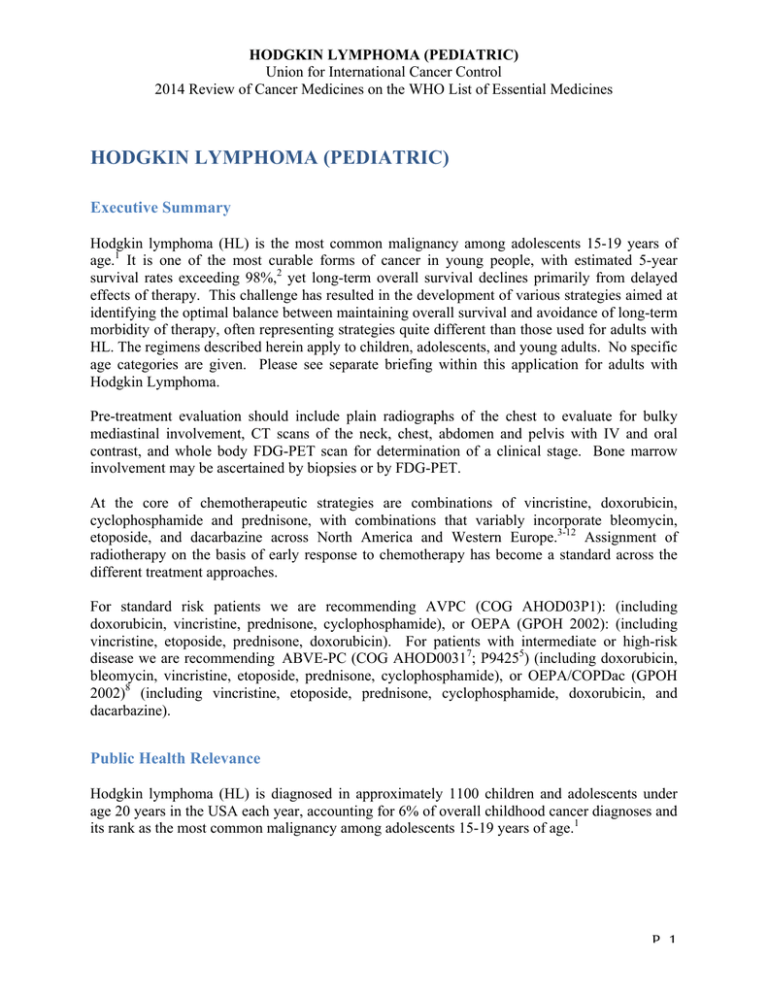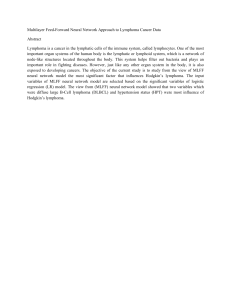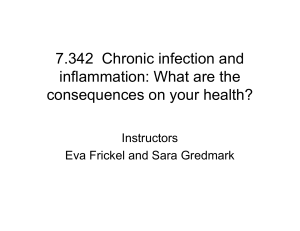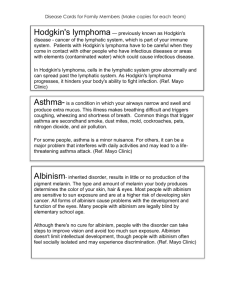UICC EML Review - Hodgkin Lymphoma (Pediatric)
advertisement

HODGKIN LYMPHOMA (PEDIATRIC) Union for International Cancer Control 2014 Review of Cancer Medicines on the WHO List of Essential Medicines HODGKIN LYMPHOMA (PEDIATRIC) Executive Summary Hodgkin lymphoma (HL) is the most common malignancy among adolescents 15-19 years of age.1 It is one of the most curable forms of cancer in young people, with estimated 5-year survival rates exceeding 98%,2 yet long-term overall survival declines primarily from delayed effects of therapy. This challenge has resulted in the development of various strategies aimed at identifying the optimal balance between maintaining overall survival and avoidance of long-term morbidity of therapy, often representing strategies quite different than those used for adults with HL. The regimens described herein apply to children, adolescents, and young adults. No specific age categories are given. Please see separate briefing within this application for adults with Hodgkin Lymphoma. Pre-treatment evaluation should include plain radiographs of the chest to evaluate for bulky mediastinal involvement, CT scans of the neck, chest, abdomen and pelvis with IV and oral contrast, and whole body FDG-PET scan for determination of a clinical stage. Bone marrow involvement may be ascertained by biopsies or by FDG-PET. At the core of chemotherapeutic strategies are combinations of vincristine, doxorubicin, cyclophosphamide and prednisone, with combinations that variably incorporate bleomycin, etoposide, and dacarbazine across North America and Western Europe.3-12 Assignment of radiotherapy on the basis of early response to chemotherapy has become a standard across the different treatment approaches. For standard risk patients we are recommending AVPC (COG AHOD03P1): (including doxorubicin, vincristine, prednisone, cyclophosphamide), or OEPA (GPOH 2002): (including vincristine, etoposide, prednisone, doxorubicin). For patients with intermediate or high-risk disease we are recommending ABVE-PC (COG AHOD00317; P94255) (including doxorubicin, bleomycin, vincristine, etoposide, prednisone, cyclophosphamide), or OEPA/COPDac (GPOH 2002)8 (including vincristine, etoposide, prednisone, cyclophosphamide, doxorubicin, and dacarbazine). Public Health Relevance Hodgkin lymphoma (HL) is diagnosed in approximately 1100 children and adolescents under age 20 years in the USA each year, accounting for 6% of overall childhood cancer diagnoses and its rank as the most common malignancy among adolescents 15-19 years of age.1 P 1 HODGKIN LYMPHOMA (PEDIATRIC) Union for International Cancer Control 2014 Review of Cancer Medicines on the WHO List of Essential Medicines Requirements for diagnosis, treatment, and monitoring Diagnostics: HL is characterized by the presence of multinucleated giant cells (Hodgkin/Reed-Sternberg cells, H/RS) or large mononuclear cell variants (lymphocytic and histiocytic cells) accounting for approximately 1% of the cells in a background of inflammatory cells consisting of small lymphocytes, histiocytes, neutrophils, eosinophils, plasma cells, and fibroblasts. Incisional lymph node biopsy or several large needle cores are recommended for confirmation of diagnosis, rather than fine needle aspiration, in order to provide sufficient material for pathologic interpretation. Use of fine needle aspirates for determination of diagnosis is strongly discouraged due to the rarity of the H/RS cells and risk of missing the diagnosis. Two broad pathologic classes exist; classical (cHL) and nodular lymphocyte predominant (NLPHL) and immunohistochemistry for antigen expression (CD30, CD15, CD20) is used to best distinguish the types. Testing: Physical examination and diagnostic imaging evaluations (upright posteroanterior and lateral thoracic radiographs; CT of the neck, chest, abdomen, and pelvis with intravenous and oral contrast; and functional nuclear imaging studies with FDG-PET) are used to designate a clinical stage. Data from retrospective studies suggests that FDG-PET may replace the need for bone marrow biopsies in patients with clinical stage III to IV disease or B symptoms, however this has not been validated prospectively. Staging laparotomy is rarely appropriate with the imaging modalities available today, but biopsy of specific sites with equivocal findings by clinical staging should be considered when results will alter therapy. Interim assessment of response by FDGPET is incorporated into contemporary treatment approaches. However, the optimum time point for assessment and the criteria for response have not been defined. Continued surveillance for relapse with FDG-PET in the post treatment period is not recommended, due to its low positive predictive value. Administration and Care of Patients: Chemotherapy for HL is given by the IV and oral routes and consists of multiple agents. This requires careful management of fluid and electrolyte balance as well as prophylactic anti-emetic therapy and other supportive care measures. All of this is accomplished usually through a central venous catheter and so should be undertaken only in a specialized cancer center. Radiotherapy administration also requires special expertise to minimize exposure of normal tissue. Management of the side effects of chemotherapy in the short term include nausea, vomiting, mucositis, pancytopenia, and peripheral neuropathy. In the long-term, survivors are at risk for infertility (notably from cyclophosphamide or procarbazine), cardiomyopathy (especially from doxorubicin and radiotherapy), restrictive pneumonitis (especially from bleomycin and radiotherapy), hypothyroidism (from radiotherapy) and second cancers (particularly leukemia from etoposide and solid tumors in the radiation fields). P 2 HODGKIN LYMPHOMA (PEDIATRIC) Union for International Cancer Control 2014 Review of Cancer Medicines on the WHO List of Essential Medicines Classical HL. Recent trials (summarized in Tables 1a and 1b) have utilized chemotherapy regimens of varying dose intensity, and have significant differences in the criteria for omission of radiotherapy. The European consortium has investigated OEPA (vincristine, etoposide, prednisone, doxorubicin) for low risk, and OEPA with COPDac (cyclophosphamide, vincristine, prednisone, dacarbazine) for intermediate and high risk groups. In North America, the Children’s Oncology Group has primarily evaluated ABVE-PC (doxorubicin, bleomycin, vincristine, etoposide, prednisone, cyclophosphamide) and its derivatives across the risk groups.5-7,11,12 Radiotherapy usage varies considerably. The Children’s Oncology Group recently reported that radiotherapy may be safely omitted in intermediate risk patients who have a rapid reduction in tumor dimensions by CT after 2 cycles of chemotherapy.7 The European consortium has omitted radiotherapy for low risk patients achieving a CR after 2 cycles of OEPA.8 In general, pediatric radiotherapy approaches utilize lower doses (15-25Gy) and smaller fields (involved field or nodes) than in adult patients.3-12 Nodular Lymphocyte Predominant HL. Surgery alone could be considered for completely resected stage I disease. For stage IIA or incompletely resected stage IA, reduced chemotherapy with a regimen such as doxorubicin, vincristine, prednisone and cyclophosphamide (AVPC) could be used based on results from the COG AHOD03P1 trial.12 Radiation can likely be restricted to only those patients with a less than a complete response after 3 cycles of chemotherapy. The approach eliminates radiation for >90% of patients. There is an ongoing EuroNet study evaluating a similar approach with the anthracycline-free regimen of cyclophosphamide, vinblastine, and prednisone (CVP). As this study is ongoing, we do not yet have data on this approach. Overview of Regimens The following tables include basic information on administration and dosing for the Children’s Oncology Group and European Consortium regimens, and exclude ancillary medications pertaining to the management of side effects. Standard Regimens for Standard Risk Patients AVPC (COG AHOD03P1): three 21 day cycles12 Doxorubicin Vincristine Prednisone Cyclophosphamide IV infusion IV push PO BID IV infusion 50 mg/m2 1.4 mg/m2 (maximum 2.8 mg) 20 mg/m2 Days 1-7 800 mg/m2 OR OEPA (GPOH 2002): two 28 day cycles8 Vincristine IV push 1.5 mg/m2 (maximum 2 mg) Days 1, 8, 15 P 3 HODGKIN LYMPHOMA (PEDIATRIC) Union for International Cancer Control 2014 Review of Cancer Medicines on the WHO List of Essential Medicines Etoposide Prednisone Doxorubicin IV infusion PO BID IV infusion 125 mg/m2 Days 2-6 30 mg/m2 Days 1-15 40 mg/m2 Days 1, 15 Standard Regimens for Intermediate or High Risk Patients ABVE-PC (COG AHOD00317; P94255): Four (intermediate risk) or five (high risk) 21 day cycles: Doxorubicin IV infusion 25 mg/m2 Days 1,2 Bleomycin IV infusion 5 units/m2 Day 1 10 units/m2 Day 8 Vincristine IV push 1.4 mg/m2 (maximum 2.8 mg) Days 1, 8 Etoposide IV infusion 125 mg/m2 Days 1, 2, 3 Prednisone PO BID 20 mg/m2 Days 1-7 Cyclophosphamide IV infusion 800 mg/m2 Day 1 OR OEPA/COPDac (GPOH 2002)8: Two 28 day cycles: Vincristine Etoposide Prednisone Doxorubicin IV push IV infusion BID PO BID IV infusion 1.5 mg/m2 (maximum 2 mg) Days 1, 8, 15 125 mg/m2 Days 2-6 30 mg/m2 Days 1-15 40 mg/m2 Days 1, 15 Two (intermediate risk) or four (high risk) 28 day cycles: Cyclophosphamide IV infusion 500 mg/m2 Days 1 and 8 Vincristine IV push 1.5 mg/m2 Days 1 and 8 (maximum 2 mg) Prednisone PO 40mg/m2 Days 1 to 15 2 Dacarbazine IV infusion 250 mg/m Days 1 to 3 Review of Benefits and Harms Survival Benefits The overall 5 years relative survival for 2002–2008 from the SEER database was 84.7%. Children and adolescents have significantly better HL-specific survival than adults (5 years survival rate, 96%±0.4% vs. 88% ± 0.3%, P < 0.001).2 P 4 HODGKIN LYMPHOMA (PEDIATRIC) Union for International Cancer Control 2014 Review of Cancer Medicines on the WHO List of Essential Medicines Harms and Toxicity Considerations Common Pediatric patients receiving combination chemotherapy for HL will experience significant hematotoxicity including severe neutropenia increasing risk of infection, as well as high incidences of anemia and thrombocytopenia. The incidence of serious infection including sepsis is relatively high, occuring in 8-17% of patients.5,7 Many patients also experience stomatitis and mucositis from combined therapy. Vincristine commonly causes neurotoxicity, including sensory and motor neuropathies, which is typically dose-related. Neurotoxicity is usually reversible, and in the regimens above is typically mild. A small percentage (up to 2%) of patients receiving intravenous etoposide experience hypersensitivity reactions, which may include angioedema, bronchospasm, and/or chest discomfort.13 Serious Patients should be monitored for symptoms indicating the existence of long-term toxicity, particularly of heart and lung as well as secondary malignancy. Treatment with bleomycin may result in late bleomycin-related pulmonary toxicity, therefore, a high index of suspicion is warranted to allow omission of the bleomycin as early as possible when toxicity occurs. Doxorubicin is associated with a risk of cardiotoxicity. Development of severe heart failure is uncommon, however myocardial dysfunction may appear in long-term follow up. In pediatric patients, the risk of heart failure and pericardial disease increases with cumulative doses ≥250mg/m2.14 Survivors are also at risk of secondary malignancy, associated most commonly with etoposide and dacarbazine in the regimens above. Though the risk remains small (<3% in pediatric HL trials listed), patients should be closely monitored for this development.5,7 Survivors are also at risk for infertility, most notably from cyclosphosphamide. Systematic Reviews • Kelly KM. Management of children with high-risk Hodgkin lymphoma. British Journal of Haematology, 2012 ;157:3-13. o Abstract: This review summarizes recent clinical trials in pediatric high risk HL, along with key findings from studies in adults with high risk HL that are applicable to the pediatric population. New directions in prognostic classification and targeted therapies are reviewed. Considerations for clinical practice at the current time outside the clinical trial setting are provided. • Allen CE, Kelly KM, Bollard CM. Pediatric lymphomas and histiocytic disorders of childhood. Pediatr Clin North Am. 2015 ;62:139-165. P 5 HODGKIN LYMPHOMA (PEDIATRIC) Union for International Cancer Control 2014 Review of Cancer Medicines on the WHO List of Essential Medicines o Abstract: Although there have been dramatic improvements in the treatment of children with Non-Hodgkin lymphoma, Hodgkin lymphoma and Histiocytic disorders over the past 3 decades, many still relapse or are refractory to primary therapy. In addition, late effects such as 2nd malignancies, cardiomyopathy and infertility remain a major concern. Thus, this review focuses on the current state of the science and, in particular, novel treatment strategies that are aimed at improving outcomes for all pediatric patients with lymphoma and histiocytic disorders while reducing treatment related morbidity. • Terezakis SA, Metzger ML, Hodgson DC et al. ACR Appropriateness criteria pediatric Hodgkin lymphoma. Pediatr Blood Cancer. 2014 ;61:1305-1312. o Abstract: Pediatric Hodgkin lymphoma is a highly curable malignancy and potential long-term effects of therapy need to be considered in optimizing clinical care. An expert panel was convened to reach consensus on the most appropriate approach to evaluation and treatment of pediatric Hodgkin lymphoma. The American College of Radiology Appropriateness Criteria are evidence-based guidelines for specific clinical conditions that are reviewed every 2 years by a multidisciplinary expert panel. The guideline development and review include an extensive analysis of current medical literature from peer reviewed journals and the application of a well-established consensus methodology (modified Delphi) to rate the appropriateness of imaging and treatment procedures by the panel. In those instances where evidence is lacking or not definitive, expert opinion may be used to recommend imaging or treatment. Four clinical variants were developed to assess common clinical scenarios and render recommendations for evaluation and treatment approaches to pediatric Hodgkin lymphoma. We provide a summary of the literature as well as numerical ratings with commentary. By combining available data in published literature and expert medical opinion, we present a consensus to the approach for management of pediatric Hodgkin lymphoma. Recommendations The reviewers recommend the incorporation of pediatric Hodgkin lymphoma treatment options into the WHO Model List of Essential Medicines, and recommend specifically that etoposide and dacarbazine be added for pediatric indications to the core Essential Medicines List. Medicines proposed for Section 8.2 of the Child EML Etoposide Dacarbazine P 6 HODGKIN LYMPHOMA (PEDIATRIC) Union for International Cancer Control 2014 Review of Cancer Medicines on the WHO List of Essential Medicines References 1. Howlader NNA, Krapcho M, Neyman N, et al. editors. Surveillance Epidemiology and End Results (SEER) cancer statistics review, 1975–2009 (Vintage 2009 Populations). Bethesda, MD: National Cancer Institute. 2. Bazzeh F, Rihani R, Howard S, et al. Comparing adult and pediatric Hodgkin lymphoma in the Surveillance, Epidemiology and End Results program, 1988–2005: An analysis of 21,734 cases. Leuk Lymphoma 2010;51:2198–2207. 3. Wolden SL, Chen L, Kelly KM, et al. Long-term results of CCG 5942: A randomized comparison of chemotherapy with, without radiotherapy for children with Hodgkin lymphoma. J Clin Oncol 2012;30:3174–3180. 4. Kelly KM, Sposto R, Hutchinson R, et al. BEACOPP chemotherapy is a highly effective regimen in children and adolescents with high risk Hodgkin lymphoma: A report from the Children’s Oncology Group CCG-59704 clinical trial. Blood 2011;117:2596–2603. 5. Schwartz CL, Constine LS, Villaluna D, et al. A risk-adapted, response-based approach using ABVEPC for children and adolescents with intermediate- and high-risk Hodgkin lymphoma: The results of P9425. Blood 2009;114:2051–2059. 6. Keller FG, Nachman J, Constine L, et al. A phase III study for the treatment of children and adolescents with newly diagnosed low risk Hodgkin lymphoma (HL) [abstract]. ASH Annual Meeting Abstracts 2010; 116: p. 767. 7. Friedman DL, Wolden S, Constine L, et al. Dose-intensive response-based chemotherapy and radiation therapy for children and adolescents with newly diagnosed intermediate risk Hodgkin lymphoma: AHOD0031 – A report from the Children’s Oncology Group. J Clin Oncol. 2014 ;32:3651-3658. 8. Mauz-Ko¨rholz C, Hasenclever D, Do¨rffel W, et al. Procarbazine-free OEPA-COPDAC chemotherapy in boys and standard OPPA-COPP in girls have comparable effectiveness in pediatric Hodgkin’s lymphoma: The GPOH-HD-2002 study. J Clin Oncol 2010;28:3680–3686. 9. Metzger ML, Weinstein HJ, Hudson MM, et al. Association between radiotherapy vs no radiotherapy based on early response to VAMP chemotherapy, survival among children with favorable-risk Hodgkin lymphoma. JAMA 2012;307:2609–2616. 10. Metzger M, Billett A, Friedmann AM, et al. Stanford V chemotherapy and involved field radiotherapy for children and adolescents with unfavorable risk Hodgkin lymphoma: Results of a multi-institutional prospective clinical trial. J Clin Oncol 2012;30:9502. 11. Tebbi CK, Mendenhall NP, London WB, et al. Response-dependent and reduced treatment in lower risk Hodgkin lymphoma in children and adolescents, results of P9426: A report from the Children’s Oncology Group. Pediatr Blood Cancer 2012;59:1259–1265. 12. Appel, B., Chen, L., Hutchinson, R.J., et al. (2014) Treatment of Pediatric Lymphocyte Predominant Hodgkin Lymphoma (LPHL): A Report from the Children's Oncology Group. Klin Padiatr, 226, Oral Presentation O-10. 13. Etoposide. DrugPoints Summary. Micromedex 2.0. Truven Health Analytics, Inc. Greenwood Village, CO. 14. Floyd J, Morgan JP. Cardiotoxicity of anthracycline-like chemotherapy agents. In: UpToDate, Post TW (Ed), UpToDate, Waltham, MA, 2014. P 7 HODGKIN LYMPHOMA (PEDIATRIC) Union for International Cancer Control 2014 Review of Cancer Medicines on the WHO List of Essential Medicines Table 1a. Results of Recent Trials for Pediatric low-risk HL. Group Europe French Society of Pediatric Oncology German Society of Pediatric Oncology and Hematology Study n LR Definition Chemotherapy RT (dose, field) EFS or DFS, OS (yr) MDH90 202 IA, IB, IIA, IIB VBVP x 4 (+ OPPA x 1-2 if PR after cycle 4) 20-40Gy IF 91.1%, 97.5% (5yr) GPOH-HD-95 328 IA, IB, IIA OPPA (female); OEPA (male) x 2. CR after cycle 2: no RT PR after cycle 2: 2030Gy IF 93.2%, 98.8% (10yr) GPOH-HD-2002 195 IA, IB, IIA OPPA (female); OEPA (male) x 2 CR after cycle 2: no RT PR after cycle 2: 2030Gy IF 92%, 99.5% (5yr) 110 IA, IB, IIA, IIB no bulk, no E IA, IIA, <3 nodal sites, no bulk, no E IA, IB, IIA without adverse + features VAMP x 4 15 -22.5 Gy IF VAMP x4 CR after cycle 2: no RT PR after cycle 2: 25.5Gy IF 89.4%, 96.1% (10yr) EFS: 90.8% (2yr) COPP/ABV x 4 CR after cycle 4: randomized to 21Gy IFRT vs. no RT PR: 21Gy IF DBVE x 2-4 (based on response after cycle 2) AV-PC x 3 25.5 Gy IF North America Stanford, Dana Farber, St. Jude consortium CCG, POG, and COG 88 CCG 5942 294 P9426 294 IA, IB, IIA, IIIA AHOD0431 287 IA, IIA, no bulk CR after cycle 3: no RT PR after cycle 3: 21 Gy IF 10 yr EFS IFRT: 100% no RT: 89.1% (p=.001) 10 yr OS: RT: 97.1% no RT: 95.9% (p=0.5) 86.2% 97.4% (8yr) 79.8% 99.6% (4yr) P 8 HODGKIN LYMPHOMA (PEDIATRIC) Union for International Cancer Control 2014 Review of Cancer Medicines on the WHO List of Essential Medicines Table 1b. Results of Recent Trials for Pediatric Intermediate and High risk HL. Group Europe German Society of Pediatric Oncology and Hematology North America CCG, POG, and COG Study n Definition Chemotherapy RT (dose, field) EFS or DFS, OS (yr) GPOH-HD95 341 2 OPPA/OEPA + 4 COPP . CR after cycle 2: no RT PR after cycle 2: 20-35Gy IF 84.5%, 93.2% (10yr) GPOH-HD2002 Intermediate: 139 High: 239 Intermediate: IEA/B; IIEA; IIB; IIIA High: IIEB; IIIEA/B; IIIB; IV Intermediate: IEA/B; IIEA; IIB; IIIA High: IIEB; IIIEA/B; IIIB; IV OPPA (female); OEPA (male) x 2 Intermediate: COPDAC x 2 High: COPDAC x 4 19.8-35 Gy IF Intermediate: 88.3%, 99.5% High: 86.9%, 94.9% (5yr) CCG 5942 Intermediate: 394 High: 141 Intermediate; IA, IB, IIA with adverse + features ; IIB, III High: IV Intermediate: COPP/ABV x 6 High: COPP/ABV, CHOP, Etoposide /Cytarabine x 2 CR after cycle 6: randomized to 21Gy IFRT vs. no RT PR: 21Gy IF P9425 Intermediate: 53 High: 163 Intermediate: IB, IIALMA, IIIA High: IIB, IIIB, IV DBVE-PC x 3-5 (based on response after cycle 3) 25.5 Gy IF Intermediate: RT: 87%, 95% No RT: 83%, 100%; High: RT: 90%, 100% No RT: 81%, 94% (EFS p<.05) Intermediate: 84%, OS NR High: 85%, OS NR (5yr) C59704 99 IIB/IIIB + bulk, IV M RER: 21 Gy IF F RER: No RT SER: 21 Gy IF 94%, 97% (5 yr) AHOD0031 1712 IA, IIA + bulk, IB, IIB, IIIA, IVA BEACOPPx 4 M RER: ABVD x 2 F RER : COPP/ABV x 4 SER: BEACOPP x 4 ABVE-PC x 4 SER: Randomized DECA x 2 Randomized RER after cycle 2 and CR after cycle 4: no RT All others: 21 Gy IF 85.6%, 98.2% (3 yr) VBVP: vinblastine, bleomycin, etoposide, prednisone OPPA: vincristine, procarbazine, prednisone, doxorubicin OEPA: vincristine, etoposide, prednisone, doxorubicin VAMP: vinblastine, doxorubicin, methotrexate, prednisone COPP/ABV: cyclophosphamide, vincristine, procarbazine, prednisone, doxorubicin, bleomycin, vinblastine DBVE: doxorubicin, bleomycin, vincristine, etoposide AV-PC: doxorubicin, vincristine, prednisone, cyclophosphamide COPDac: cyclophosphamide, vincristine, prednisone, dacarbazine CHOP: cyclophosphamide, doxorubicin, vincristine, prednisone DBVE-PC: doxorubicin, bleomycin, vincristine, etoposide, prednisone, cyclophosphamide BEACOPP: bleomycin, etoposide, doxorubicin, cyclophosphamide, vincristine, prednisone, procarbazine ABVE-PC: doxorubicin, bleomycin, vincristine, etoposide, prednisone, cyclophosphamide DECA: dexamethasone, etoposide, cisplatin, cytarabine IF: involved field RT: radiation therapy M: male P 9 HODGKIN LYMPHOMA (PEDIATRIC) Union for International Cancer Control 2014 Review of Cancer Medicines on the WHO List of Essential Medicines F: female RER: rapid early responder SER: slow early responder CR: complete response PR: partial response + adverse features = hilar disease, bulk, ≥4 nodal regions, mediastinal tumor P 10




